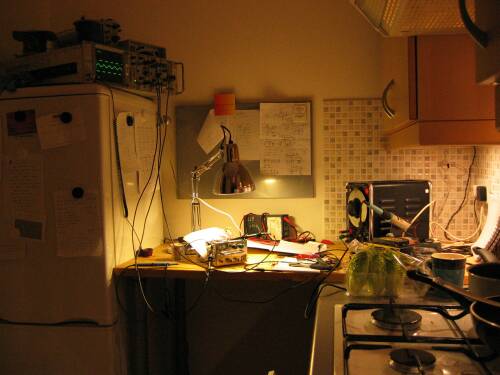DRSSTC experimental work

What's cooking in your kitchen?
I'm currently working towards the goal of a big DRSSTC that will out-arc the OLTC II. But I want it to be reliable. This is why I need all the theory and modelling work, so I can say with confidence "it will produce 10 foot sparks and never blow up." But I also need to build the danged thing, hence the experimental work. I'm aiming to build a tabletop unit first with the same driver circuit as the full size one, so I can do tests with less risk to life and limb.
This is a summary of progress as of January 10th 2005.
Peak current limiting and monitoring
A reliable DRSSTC needs a circuit that will monitor the primary current and briefly cut the drive if it gets above a safe level. I have designed a limiter and will be testing it in the next few weeks.
I also think it would be good to have a meter that reads the peak primary current. It should make tuning easier and help you figure out WHY the IGBTs exploded this time... I have designed a fast peak holding detector that processes the signal from a CT or Rogowski coil and drives an ordinary analogue meter. I am testing it on the Mini OLTC with a Rogowski coil right now. It seems promising but could perhaps be made a bit more accurate?
Driving large IGBTs
Brick sized IGBTs require a higher gate voltage and a lot more current. Many devices are also quite slow and so need a drive waveform with deadtime to avoid the dreaded Shoot-Through. I have designed a gate drive booster stage and a SMPS to supply it. The SMPS has been built and tested but the boosters themselves are not built yet.
I am in the middle of modifying the PLL driver to add deadtime. So far I have got it adjustable between 100ns and 1.5us, but the mod turned up a bunch of other problems that made me decide to go for a more radical redesign. By running the VCO at twice the output frequency and dividing by two, I can get what I want with a simpler circuit and get rid of that annoying 90' phase offset while I'm at it.
I now have the new PLL with divide-by-two and increased loop gain working on the bench.
Accurate zero current switching
If the drive is too badly out of phase the IGBTs may be asked to interrupt too high a current, and go into dynamic latchup. I believe that the PLL driver with primary current feedback is already accurate enough but I will check it further.
Other annoying things
All the little stuff like safety interlocks, remote control to operate it from a safe distance, undervoltage lockout to prevent starting up with inadequate gate drive, a SS Variac like in the OLTC II to save lugging a 20A variac around, etc.
Return to Tesla page

